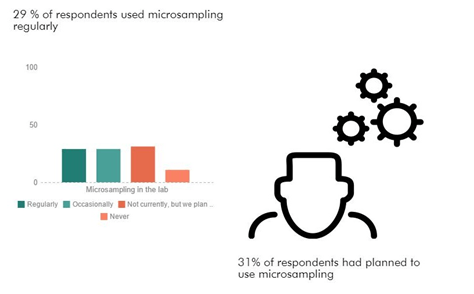Microsampling: Where the road ahead has since led to…

Two years ago Bioanalysis Zone hosted an engaging Spotlight on microsampling – Microsampling: the road ahead. We engaged with a number of leading experts within the bioanalytical community to discuss their experiences using microsampling, the current state of the field, in addition to looking at what the road ahead looked like for the field.
In a series of stimulating webinars, engaging commentaries, and numerous other special features we explored the emergence of microsampling in bioanalysis. We aimed to provide a wide-ranging and all-inclusive understanding of the field from a variety of perspectives that would promote discussion and help move the field forward. This event culminated in a lively panel discussion consisting of seven key experts working on various applications of microsampling.
The key message echoed in this Spotlight was the bioanalytical community’s undisputed understanding of the benefits of microsampling. There was no contention on the value of the method and its promises; at the time it appeared microsampling was enjoying expansion and utility among the broader bioanalytical base.
 To further understand the uses of and attitudes to microsampling within the bioanalytical community, as part of this Spotlight we carried out a survey. The survey revealed great optimism and confidence in the approach – approximately 60% of survey respondents confirmed that they are regular or occasional users of microsampling. Furthermore, at the time of the survey, a larger number were planning to use the technique.
To further understand the uses of and attitudes to microsampling within the bioanalytical community, as part of this Spotlight we carried out a survey. The survey revealed great optimism and confidence in the approach – approximately 60% of survey respondents confirmed that they are regular or occasional users of microsampling. Furthermore, at the time of the survey, a larger number were planning to use the technique.
Nonetheless, as optimistic as the broader attitude of the community appeared to be, it wasn’t all as straightforward as it may have seemed. The 2014 Spotlight on microsampling survey revealed that laboratories and regulators were still hesitant to adopt the technique, thus revealing another key message – a deep conundrum that existed in the community between having the knowledge and appreciation of the potential value of microsampling and hesitation in applying it.
This conundrum was further debated in the culmination of this Spotlight event – a panel discussion with key experts in microsampling. The panellists discussed the huge growth in the variety of techniques in microsampling, emphasizing how a number of these techniques are becoming well established (namely DBS) and are even being applied more routinely. Since then, these microsampling techniques have become well established with more novel technologies appearing in the market; furthermore, the development of newer, more sensitive bioanalytical instruments are also facilitating the increased application of microsampling in simpler workflows.
The success of microsampling continues to develop and remains undisputed, just as our panellists and the bioanalytical community predicted 2 years ago. It is a promising future that will only evolve further as bioanalysis continues to advance.
It is positive to see that the optimism expressed 2 years ago has since materialized to an extent – this wasn’t a case of a lackadaisical interest expressed by the community, but rather a deeply sincere and carefully measured desire to gain a better understanding of how they can do better science, and gain high-quality data in a more ethical and economical way.
 Two years later we see this sincerity materializing – according to our recent survey there has been a 20% increase in the application of microsampling compared with the results generated by our microsampling Spotlight 2 years ago. Our recent survey further showed that although microsampling is still more common in nonclinical contexts, there has been a significant increase in the application of microsampling in clinical research, this isa promising finding of microsampling’s high potential.
Two years later we see this sincerity materializing – according to our recent survey there has been a 20% increase in the application of microsampling compared with the results generated by our microsampling Spotlight 2 years ago. Our recent survey further showed that although microsampling is still more common in nonclinical contexts, there has been a significant increase in the application of microsampling in clinical research, this isa promising finding of microsampling’s high potential.
In her commentary on the 2014 survey results, Kathryn Chapman (Executive Manager at Milner Therapeutics Institute, Cambridge University; Cambridge, UK) highlighted the emphasis that companies are placing on the three Rs, with two of the five major reasons for implementing microsampling being reduction in the number of animals and refinement of procedures, reducing animal stress. It is positive to see that these same reasons continue to drive the industry to apply microsampling and in the process pave the way to achieving better science.

Perhaps it is the strong scientific spirit evident through the non-competitive collaboration across companies in this field, evidenced in recent microsampling workshops, which reflects the optimism that best captures the future of microsampling.
Below are some of the top content from our 2014 Spotlight Microsampling: the road ahead hosted on Bioanalysis Zone. Revisit this Spotlight to see how the fieldhas developed and what issues still remain.
Highlights from Spotlight on Microsampling: the road ahead
Microsampling Panel Discussion
Microsampling: the road ahead Survey Infographic
Interview with Roger Hayes (MPI Research) on microsampling in drug discovery and development
Microsampling and the bioanalytical challenges in their routine analysis
Microsampling: is the future bright?
Interview with Sufyan Maqbool (MedImmune) on capillary microsampling
This review was featured in an interactive supplement on microsampling published on Bioanalysis Zone. Click here to read the complete supplement.
Our expert opinion collection provides you with in-depth articles written by authors from across the field of bioanalysis. Our expert opinions are perfect for those wanting a comprehensive, written review of a topic or looking for perspective pieces from our regular contributors.
See an article that catches your eye? Read any of our articles below for free.






